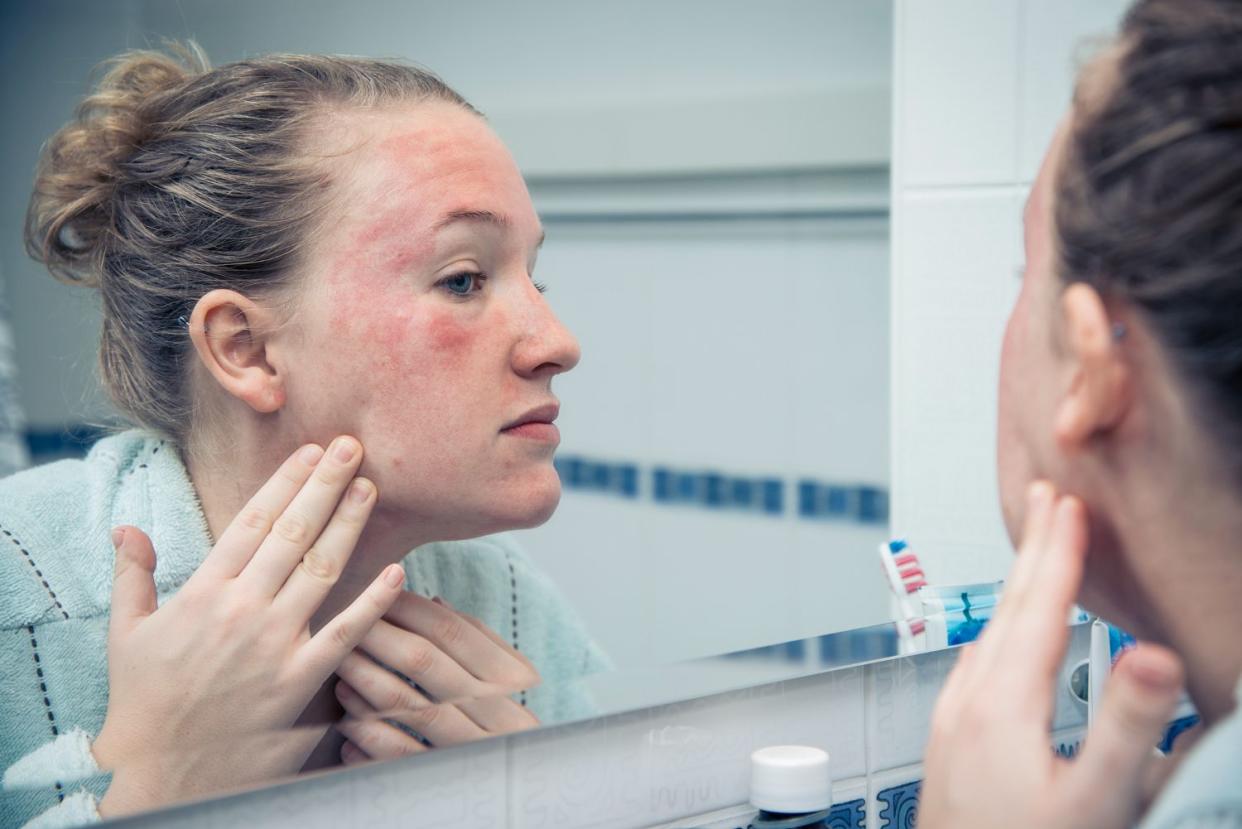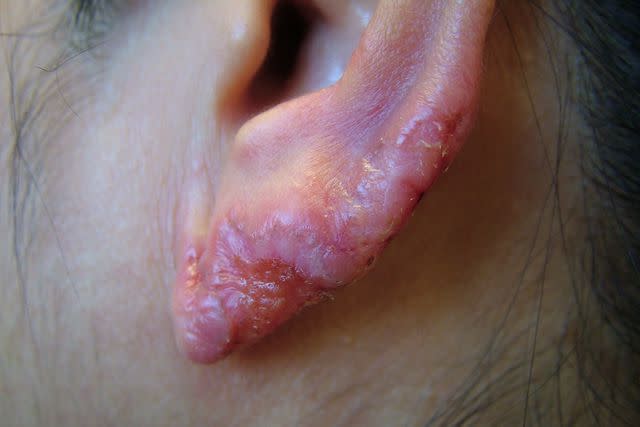Symptoms of Skin Tuberculosis

AzmanL / Getty Images
Medically reviewed by Susan Bard, MD
Skin tuberculosis (TB) is a bacterial infection that can manifest differently depending on the individual, leading to a range of symptoms, including rashes, bumps (lesions), and ulcers on various parts of the body. If left untreated, skin TB can lead to serious complications or spread to other parts of the body.
This article discusses the frequent and rare symptoms of skin TB, potential complications, and when it’s time to seek help.

Reproduced with permission from © DermNet New Zealand www.dermnetnz.org 2023.
Frequent Symptoms
Exposure to the Mycobacterium tuberculosis bacterium usually occurs in two ways: via cuts, wounds, or needle sticks or spread from the lungs or other organs. When TB affects the skin, symptoms typically arise within two to four weeks of exposure to the bacterium.
The first signs of skin TB are usually rashes and red or yellowish papules and nodules (raised bumps on the skin), which may develop into the following:
Plaques (large, dark colored-lesions)
Ulcers (open sores that may leak discharge)
Abscesses (bumps below the skin)
Other, more specific manifestations of the condition may appear as it progresses. The most common of these include the following:
Scrofuloderma can occur when TB spreads from infected lymph nodes. It first appears as painless nodules that combine and grow, eventually bursting and forming abscesses that leak discharge and dead tissue. These develop into purple-colored plaques and eventually scar. The skin of the neck, abdomen, and groin are most commonly affected.
Tuberculous verrucosa cutis is characterized by the formation of large red plaques (lesions) larger than 1 centimeter (cm) in diameter. These lesions have a characteristic white or light-colored buildup and are typically found on the hands, fingers, and toes.
Lupus vulgaris is characterized by the development of a large, singular, and irregularly shaped lesion, shiny and brown, similar in appearance to applesauce. It typically affects the face and ears and can transform into an ulcer.
Rare Symptoms
Rarer symptoms and conditions of skin TB include:
Tuberculous chancre: Also known as primary inoculation TB, this arises within two to four weeks of exposure as papules and nodules on the face, arms, or legs. These join to form painless lesions (patches of raised, pale, and discolored skin). Tuberculous chancre eventually spreads to the lymph nodes and the lymphatic system.
Erythema induratum of Bazin (EIB): EIB causes the formation of painful, purple lesions on the legs. This condition tends to affect young and middle-aged women, with symptoms coming and going, often leaving scars. Without treatment, this condition can flare up every three to four months.
Papulonecrotic tuberculids: These are large lesions seen on the feet, legs, hands, arms, and buttocks, often accompanied by fever, fatigue, and loss of energy. The lesions develop a hardened, scabby crust and cause permanent scarring.
Tuberculous orificialis: Tuberculous orificialis is the development of large, irregular ulcers in the mouth, throat, genitals, or around the anus. In women, this severe complication can spread to the fallopian tubes and endometrium (the lining of the uterus).
Granulomatous mastitis (GM): GM is most often seen in breastfeeding mothers and is characterized by tender and painful breast lesions that often scar.
Skin TB is rare, representing only 1% to 2% of TB infections outside the lungs. Most people exposed to M. tuberculosis (or other bacteria) never develop any symptoms. However, the bacteria can live in the body without causing symptoms and this is called latent TB infection (LTBI). About 5 to 10% of people with latent TB will develop TB and testing is recommended for anyone at greater risk of exposure. For those that develop symptoms, antibiotic therapy can effectively treat the condition.
Complications/Subgroup Indications
Skin TB is more prevalent in those with weaker immune systems (immunocompromised individuals). If allowed to progress, a number of complications may arise, including:
Scarring: Permanent scars may arise after the active symptoms of skin TB subside.
Necrosis: Active infection can lead to necrosis, in which portions of tissue around lesions die off. This can cause permanent indentations or depressions on the skin.
Night sweats: Some forms of skin TB cause night sweats and other systemic symptoms.
Fever: While it doesn't arise for everyone, fever may signify a more severe TB case.
Weight loss: Loss of appetite and weight loss may occur when TB spreads to the skin and throughout the body.
Lymphangitis: Skin TB can spread to the lymphatic system, a system of glands, vessels, and organs critical for immune function, causing lymphangitis. This leads to systemic symptoms, such as chills, fever, and headaches, and causes swollen lymph nodes.
Infertility: In rare cases where TB spreads to the genitals, it can cause both male and female infertility. In females, the bacteria may also affect the ovaries and endometrium (the lining of the uterus).
Other Diseases and Skin TB
Overall, skin TB is very rare; however, when it arises, it frequently accompanies health conditions that impact the immune system. These include:
Human immunodeficiency virus (HIV) and AIDS
Substance abuse
Certain cancers, especially in the neck or head
Silicosis (a lung disease from inhaled silica dust)
Low body weight
Advanced kidney disease
Organ transplant surgery
In these cases, skin TB is more likely to spread and become more severe and difficult to manage. Furthermore, some therapies for other conditions, such as radiation therapy for cancer, can hinder immune function, making cases worse.
TB and AIDS
HIV, the virus that causes AIDS, attacks the immune system, eventually compromising its function. As a result, infections and other diseases become more dangerous and fatal. TB is the leading underlying cause of death associated with this condition.
Age and Skin TB
Because infants and young children's immune systems aren't fully developed, they aren't as capable of fighting TB and preventing it from spreading to the skin. Symptoms and complications of skin TB are more likely to develop in this population, especially in regions where TB is more prevalent.
Women With Skin TB
Certain types of skin TB only affect women, including EIB and GM. TB can also affect menstruation, contraception, pregnancy, and breastfeeding.
Menstruation: TB infection is directly linked to irregularities in a woman’s monthly menstruation cycle. Severe forms of the disease can also spread to the genitals, ovaries, and endometrium, which can cause infertility.
Contraception: Since some forms of TB can become resistant to medications, healthcare providers may advise that TB-positive women of reproductive age use contraception during treatment.
Pregnancy: Having TB while pregnant may increase risks to both mother and child. While direct transmission of the disease is rare, babies born to infected and untreated mothers may have lower birth weights. Antibiotic drugs for the condition aren’t considered a risk to the fetus.
Breastfeeding: Breastmilk from TB-positive mothers undergoing treatment is safe for infants, though it’s not recommended if the breastfeeding mother is untreated for TB.
Make sure to talk to your healthcare provider or child’s pediatrician if you have skin TB or a history of the condition.
When to See a Healthcare Provider
If you see unusual symptoms on your skin, such as the formation of nodules and papules, talk to your healthcare provider. Since some forms of skin TB arise from puncture wounds or through cuts, getting help is also important if you suspect you’ve been exposed. Seek care if you’re experiencing symptoms of active TB, which include:
Chronic cough
Blood or thick phlegm when coughing
Fever
Sweats
Fatigue or weakness
Weight loss
If symptoms are present in infants and children, older adults, pregnant women, or those living with HIV/AIDS, diabetes, or another immunocompromising condition, it’s important to seek immediate medical attention.
If you’re treating skin TB, be sure to inform your healthcare provider if you notice any changes to your condition. In addition, be wary of the side effects of antibiotics; though rare, they can be severe. Get emergency help if you experience:
Rashes or hives
Difficulty breathing
Swelling in the face, eyes, or tongue
Wheezing
Stomach cramps
Sore throat, swollen lymph nodes
Fever and/or chills
Dark urine
Vomiting
Nausea
Summary
Skin tuberculosis (TB) is a form of TB that arises when bacteria infect the skin. Skin TB can cause a range of symptoms, including rashes, bumps, lesions, and ulcers, among others. Several specific skin TB manifestations may also present themselves, including scrofuloderma, tuberculous verrucosa cutis, and lupus vulgaris.
While this rare condition can have significant and lasting effects, treatments are highly successful in managing this condition.
A Word From Verywell
No matter what form they take, the symptoms of skin TB can significantly impact your daily life. Call your healthcare provider if you suspect you have skin TB or see unexplained growths on your skin. Taking care of your health means being proactive; don’t delay seeking help when needed.

